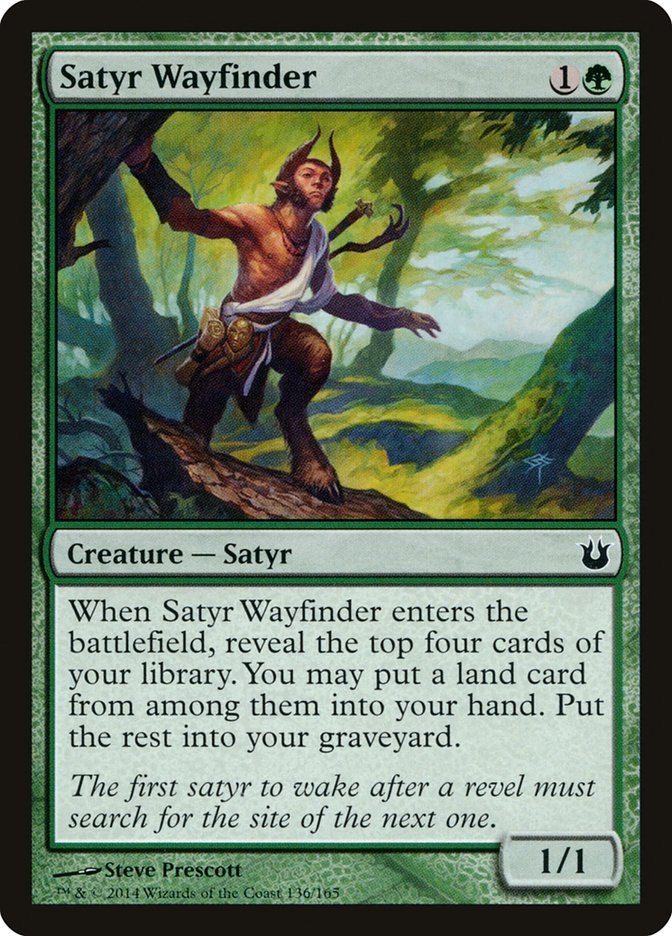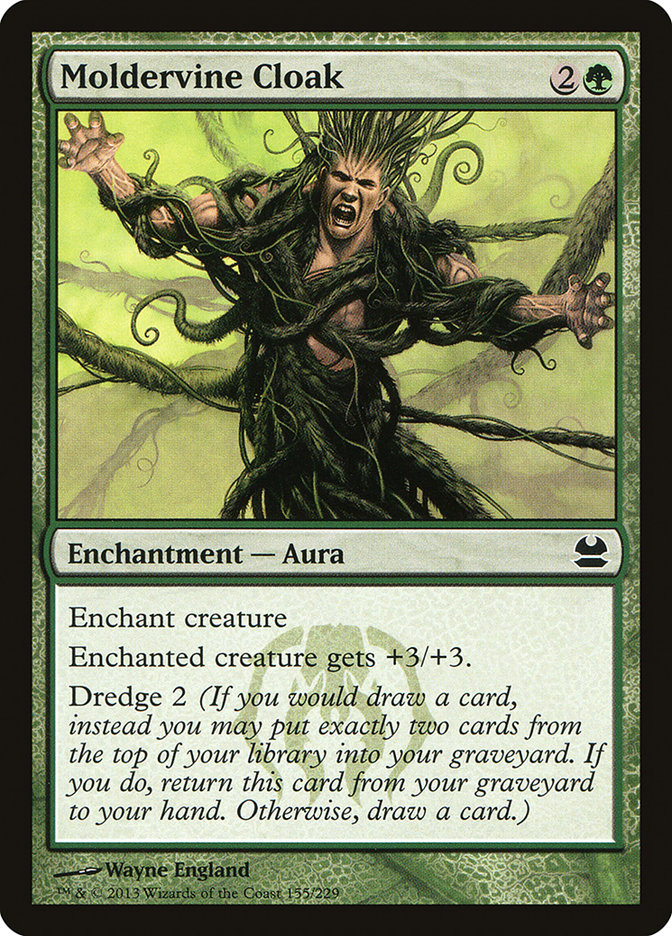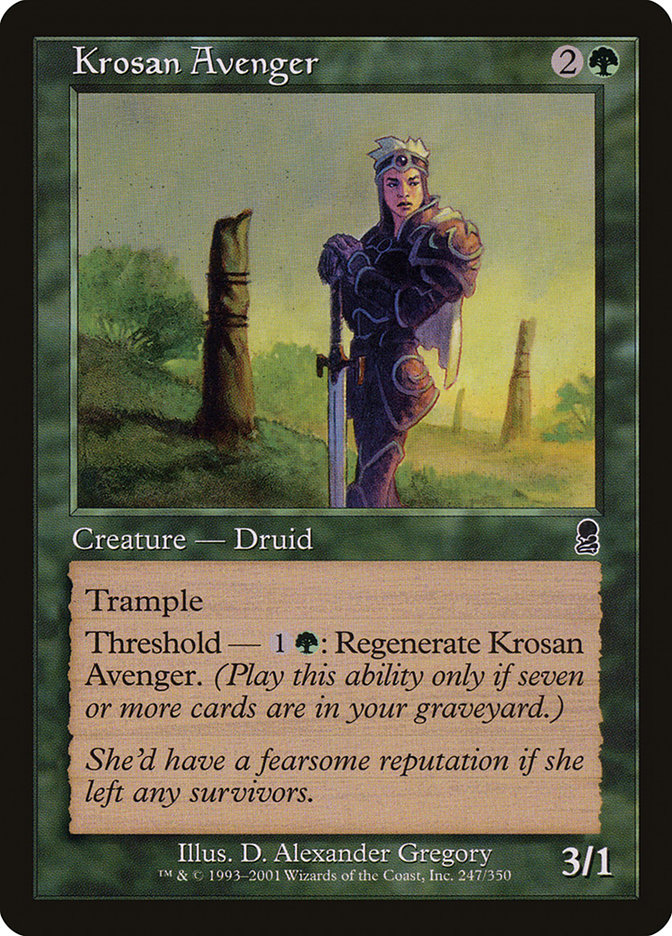About halfway through my article reviewing Born of the Gods, I started a love letter to Satyr Wayfinder. Alas, this letter was hastily written, and I could not fully expound on how I feel about this card. It’s like someone at Wizards designed an Invitational card for me, and I didn’t even have to ask! Satyr Wayfinder does everything I want in a Magic card. It can help fill the graveyard, it finds me land, and it even wears a Rancor!
If only Forbidden Alchemy could wear pants.
I’ve always been bullish on graveyard-based strategies in Pauper in part because I feel that the discard pile is a relatively untapped source of value in the format. While there are clearly some powerful cards available in Pauper—Mulldrifter, Rolling Thunder, and Gray Merchant of Asphodel just to name a few—the power level is largely flat thanks to the nature of commons. If a deck is able to make use of cards in the graveyard, then it’s eking out extra value in a relatively fair format. These incremental advantages add up over the course of the game and can allow such a deck to bury any opponent under card economy. And in such decks, Satyr Wayfinder is much closer to a draw 4 than a draw 1.
The Wayfinder definitely leads us down a path for deck construction. Building a deck to exploit this card is not difficult, but the way of the Satyr does make some demands. A Satyr Wayfinder deck must:
- Be able to play Satyr Wayfinder on the optimal turn
- Have the ability to make use of the graveyard
- Make use of the land that Satyr Wayfinder gets
The last one can be anything from using the land as that turn’s drop to fueling a card like Wild Mongrel. The middle point is where we will be looking for the bread and butter spells from formats gone by. From Flashback to scavenge, threshold to dredge, retrace to Gravediggers, there are plenty of Pauper-legal spells that can find value in the graveyard. With these in mind, I think it’s time to start looking at some potential decks.
Starting at the end of the color wheel, there’s straight green. Green is a color that likes to make use of the graveyard, but by itself it doesn’t do all that much. It has access to the more expensive end of scavenge with Drudge Beetle and Thrashing Mossdog and some of the less impressive creatures with dredge (Golgari Brownscale, anyone?), but it does have Moldervine Cloak. Green also has some of the best beaters with threshold in Werebear, Anurid Barkripper, and Springing Tiger.
Creatures (30)
Spells (30)

This is an incredibly straightforward deck. Satyr Wayfinder allows this deck to fill the yard up rather quickly, turning on its suite of threshold-enhanced creatures. Moldervine Cloak turns any creature into an actual threat, while Vines of Vastwood protects your investment. A true Gravedigger would be amazing in a deck like this, but alas, Mono-Green only has the excessively random Woodland Sleuth.
While on theme, this list probably lacks the interactive pieces needed to be a truly viable deck. It does expose some nice interactions, namely Moldervine Cloak on Krosan Avenger to build your own Yavimaya Wurm.
While green lacks Gravediggers, it is up to its ears in Cartographers. Maybe the way to make the Satyr Wayfinder work is to focus on this attribute:
Creatures (28)
Spells (32)

Half hexproof and half dredge, this deck wants to do quite a bit. Ideally, ripping through your deck at a rapid pace will allow you to turn on Monstrify and Moldervine Cloak. Retrieving a Silhana Ledgewalker with Evolution Charm and making it go big with all the enhancements could end a game in short order. Like above, this deck suffers from its inability to interact in a meaningful way. Yet the combination of Moldervine Cloak and Silhana Ledgewalker might merit some further time on the table. Looking at these two linears, maybe their sum will be more than the collection of their parts:
Creatures (34)
Spells (26)

This deck is probably the closest to being ready for testing. All the pieces fit together nicely, and it has a definite game plan of creating an attacker that’s difficult to deal with. It feels odd to not run Rancor in this deck, but without a reliable way to get the card, it feels wrong. That being said, if I wanted to play Satyr Wayfinder in a more natural habitat . . .
Creatures (28)
Spells (32)

At least this deck can find a Rancor! Flipping over this many potential Auras might lead to some "feel bad" moments, but this deck uses the super Pit-Skulk of Aura Gnarlid and Moldervine Cloak to create a rather hard to block behemoth.
I won’t lie—green has a lot to offer as a solo color. A Satyr Wayfinder deck can go down multiple roads. and thanks to the abundance of acceptable (not great) options for cards that want to live in a graveyard, those who wander in the woods can definitely brew themselves some tea.
What about the guilded wizards? Thankfully, branching into other colors provides us with some different options.
No one thinks "Gruul, that’s where I’ll make use of the graveyard." Well, these folks are mostly correct. Red is not a color that uses spent resources a second time. It kinda flies in the face of that entire "live in the now" philosophy MaRo is always talking about. However, when graveyard blocks come around, red does get some treats. The most notable card is Firebolt. The ability to take out two creatures in one card is huge, and even if it gets flipped over by a Satyr Wayfinder, five mana is not so much that it can never be cast.
Creatures (20)
Lands (4)

This is a very basic land denial deck that wants to gum up the ground early while accelerating out its own threats. Tilling Treefolk allows the deck to reclaim lands lost to Raze while also setting up Gorger Wurm (which is just big enough to dodge Flame Slash). Icefall is a sweet card since it’s the gift that keeps on taking lands from your opponent. Is there enough here for a deck? Maybe at the moment since decks utilizing Urza’s Mine, Urza’s Power Plant, and Urza’s Tower are present in the metagame in addition to some decks using Izzet Boilerworks. The numbers might be off, but this is definitely a decent starting point for blowing up lands.
Is there a way to harness the aggressive nature of Gruul while also working with Satyr Wayfinder? Perhaps. Firebolt is not the most aggressive card, but it does deal damage. Wild Hunger and Death Spark both are decks that reward playing with creatures and can be the source of quite a bit of damage over the course of a game. Working with Wayfinder and his best friend Werebear maybe the way to play green and red is to just beat down.
Creatures (30)
- 4 Mogg Fanatic
- 4 Wild Mongrel
- 4 Basking Rootwalla
- 4 Werebear
- 4 Krosan Avenger
- 4 Mogg War Marshal
- 2 Vithian Stinger
- 4 Satyr Wayfinder
Lands (4)
Spells (26)

Mogg War Marshal and Moldervine Cloak provide a nice interaction. The lack of Rancor, Lightning Bolt, and Firebolt are all glaring, but for a test build I would much rather push the envelope with regards to the theme. While the numbers might be off in this list, the core concept of attacking is a tried and true strategy.
So maybe trying to go Gruul is a stretch. The options exist, but the decks might be a tad too narrow to work. What about green’s other ally, white? White’s trip to the fengraf usually involves enchantments with cards like Auramancer and Griffin Dreamfinder. Plains magi also are adept at retrieving artifacts with Sanctum Gargoyle and Remember the Fallen. Finally, this combo has some sweet Flashback cards in Travel Preparations and Thrill of the Hunt. In fact, those last few cards go pretty well in a deck that wants to go heroic.
Creatures (24)
- 4 Silhana Ledgewalker
- 4 Wingsteed Rider
- 4 Hopeful Eidolon
- 4 Akroan Skyguard
- 4 Satyr Wayfinder
- 4 Setessan Oathsworn
Lands (4)
Spells (32)

This deck can hit hard. A mashup of hexproof and heroic can get off to some pretty sweet starts. This list is probably a bit too greedy when it comes to mana and could benefit from some number of Avacyn’s Pilgrims and Elvish Mystics. Testing will help reveal the correct numbers. Moving closer to hexproof could make better use Auramancer as a tool to regrow lost toys.
Creatures (22)
Lands (2)
Spells (36)

This deck is quite greedy and not as streamlined as the traditional hexproof strategy. While it has a slightly better late game, it does give up some resilience to removal that makes the Aura deck so enticing. It’s possible that in order for hexproof strategies to succeed they need to move in this direction, but those decks are laser focused so chances are their current iterations are better.
Maybe this is the wrong direction for Auramancer. Perhaps the way to go is to use white’s excellent enchantment-based removal as part of a more controlling deck.
Creatures (20)
Lands (4)
Spells (36)

This deck excites me. It’s approaching the game from a "destroy all monsters" perspective, except the monsters do not actually get destroyed. Instead, they are taking trips down paths to nowhere while cards like Nyxborn Wolf provide a way to punch through. Leafcrown Dryad might be better in the long run, yet the Wolf seems like a better game-ending threat in a slower deck. Also, it’s kinda entertaining to imagine a Squadron Hawk enhanced with the power of the wolf!
Kor Skyfisher pulls a ton of weight here. It helps to reuse Auramancer and allows Faith’s Fetters to gain even more life. It also retrieves a Nyxborn Wolf that was played as a creature and lets it be recycled as an Aura. All in all, this is one of the more interesting lists presented today.
White definitely provides some options that warrant further investigation. Travel Preparations alone makes putting cards into the graveyard an enticing prospect. Selesnya is a cheap Raise Dead effect away from making such a deck work.
If there is a guild for me that’s not Golgari, it’s Simic. I love the interplay of green and blue, and one of my earliest Pauper decks was based around Wild Mongrel, Werebear, Basking Rootwalla, and Deep Analysis. You know what works great in a deck like that?
Creatures (18)
Lands (4)
Spells (38)

For fans of Odyssey Block Constructed, this deck makes use of some of the most synergy-driven two-drops of all time. Pauper may lack Circular Logic, but it does have Rune Snag. While the first one is always worse than Mana Leak, two through four are far better. Aether Burst is a fine card, but Silent Departure might be better considering how few decks currently play out a ton of creatures. Think Twice and Deep Analysis form a formidable card advantage engine that doesn’t mind working with Wayfinder.
Another card that in some senses wants to be in the graveyard is Accumulated Knowledge. A powerful draw engine in its own right, Accumulated Knowledge can bury an unprepared opponent under cards. Blue and green do not normally team up in Pauper, but maybe with Satyr Wayfinder the time is nigh.
Creatures (14)
Lands (6)
Spells (40)

The above deck draws inspiration from the current crop of Izzet Control decks, which backs up blue card advantage with excellent red removal. This deck relies on blue removal and green for a potent game-ending threat in Nessian Asp. While the main 60 is nearly all blue, green could give the deck some much needed help in the sideboard with cards such as Moment’s Peace and Wickerbough Elder.
Okay, even I will admit this one is a stretch of a deck. What can I say? The idea of flipping over Deep Analysis with Satyr Wayfinder was simply irresistible. You know what else is hard to avoid? Talking about blue decks without trying to fit in Delver of Secrets.
Creatures (14)
Lands (2)
Spells (44)

Serum Visions seems out of place, especially with Preordain in the format. In this deck, not only does it help to set up Wayfinder, but it can also help to plot out a Delver of Secrets transformation. It’s easy to think of Ponder and Preordain as objectively more powerful, but I have long been interested in Serum Visions playing nice with Insectile Aberration, and this deck gives me an opportunity to try it out. Otherwise this deck plays a lot like a typical aggro control list in attempting to stick and protect a threat. Vines of Vastwood is a nice choice here, as it acts as both a counter to protect a creature and can help end the game. This is near the top of the list for decks I’m going to try once Born of the Gods goes digital.
Finally, we come to Golgari, the guild to which I feel the closest kinship. Black is a natural home for a deck featuring Satyr Wayfinder due to the abundance of Gravediggers and Disentombs. Golgari decks also gain access to Raven’s Crime, which plays especially nice with cards like the Wayfinder and Mulch. But let’s look at something a little more aggressive first.
Creatures (23)
- 1 Golgari Brownscale
- 2 Shambling Shell
- 4 Dregscape Zombie
- 4 Viscera Dragger
- 4 Rotting Rats
- 4 Putrid Leech
- 4 Satyr Wayfinder
Lands (13)
Spells (24)

While one note, this deck can present some impressive openings. It can flip over multiple creatures off of either Satyr Wayfinder or Grisly Salvage and set up a graveyard-fueled attack. Moldervine Cloak again finds a space even if Rancor would likely do a better job of helping to punch through. This is clearly a first pass deck, but if we want Satyr Wayfinder to bring the undead beats, this would be a place to start.
This deck also presents an interesting package of Satyr Wayfinder, Rotting Rats, and Raven’s Crime. Together these cards can provide the backbone for a solid resource denial deck in the vein of Smallpox. To wit:
Creatures (22)
- 2 Yavimaya Elder
- 4 Chittering Rats
- 1 Shambling Shell
- 4 Stinkweed Imp
- 3 Tilling Treefolk
- 4 Rotting Rats
- 4 Satyr Wayfinder
Lands (18)
Spells (20)

Instead of trying to beat down first, Ratyrs wants to grind the game to a halt. Stinkweed Imp stops just about any potential attacker while also playing well with Innocent Blood. Yavimaya Elder and Tilling Treefolk provide ample fuel for Raven’s Crime and aid in stripping the opponent’s hand. Shambling Shell and Moldervine Cloak provide a shot in the arm to help close out games. If anything, this deck may have too many creatures.
What if we go in the other direction? Instead of filling the yard with disruptive elements, what happens if we fill the bin with some of the best beaters available?
Creatures (30)
- 4 Krosan Tusker
- 4 Skittering Horror
- 4 Wild Mongrel
- 2 Twisted Abomination
- 4 Putrid Imp
- 4 Putrid Leech
- 4 Ulamog's Crusher
- 4 Satyr Wayfinder
Lands (9)
- 9 Swamp
Spells (21)

Reanimator strategies come with some baggage in the realm of commons. With Exhume being the only unrestricted spell, there’s always a chance that the cards will not be drawn in the correct order. On top of that, only Ulamog’s Crusher presents the kind of "must stop" threat, and even then it fulfills the prophecy of dying to Doom Blade. Unearth on Skittering Horror or Putrid Leech provides some redundancy, but my hopes for this style of deck are not high.
And so we come to the final deck of the day. In my last article, I alluded to Satyr Wayfinder making its home in Golgari Tortured Existence decks. Since that is where this unabridged love letter started, it only makes sense for it to end there as well.
Creatures (28)
- 4 Carrion Feeder
- 3 Wild Mongrel
- 4 Basking Rootwalla
- 1 Vampire Hounds
- 3 Faceless Butcher
- 2 Golgari Brownscale
- 4 Stinkweed Imp
- 3 Grave Scrabbler
- 4 Satyr Wayfinder
Lands (16)
Spells (16)

Tortured Existence wants to play the long game. These decks have traditionally won by exhausting the adversary of all threats and winning through a large Carrion Feeder, Wild Mongrel, or Vampire Hounds. Grave Scrabbler and Basking Rootwalla work with the eponymous enchantment to generate card advantage, while two Golgari Brownscales allow the deck to gain two life for each black mana available. Satyr Wayfinder and Commune with the Gods help accelerate the deck toward a full graveyard while also digging toward Tortured Existence. More than other Pauper decks, Tortured Existence must be tuned to predicted metagames. While this one isn’t tournament ready, it’s where I would start my journey.
Sixteen different options all fueled by a single card. The desire to reduce the shuffling load screen has led Wizards of the Coast to investigate other ways of searching out lands. The result is Satyr Wayfinder. As shown, this common experiment can fuel a wide swath of decks from aggro to control and resource denial to Reanimator. I can’t wait to try out Simic Delver and Golgari Tortured Existence, and Auramancer Control is calling me with a siren song. Which of these decks is your favorite? How do you plan on using Satyr Wayfinder?
One thing is for sure: the New World Order doesn’t make commons weaker. The quest for simplicity means that the powerful cards Pauper does receive are that much more elegant. And that’s a good thing.



